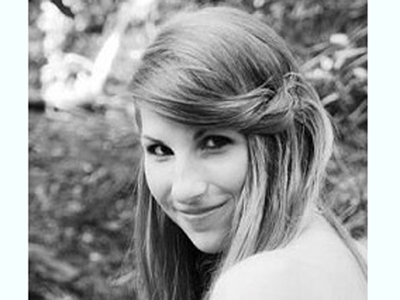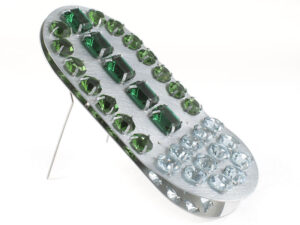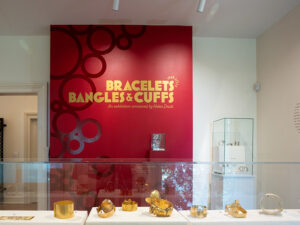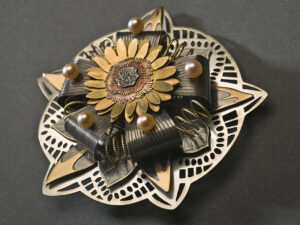Veleta Vancza has developed a new approach to adorning the body with precious metals. MINE, her line of luxury nail lacquer, was recently presented at the Heidi Lowe Gallery in Rehoboth Beach, Delaware. In this interview, Veleta explains her concept and its connection to jewelry.

Missy Graff: Please tell me about your background. How did you come to be a jeweler?
Veleta Vancza: I took my first jewelry class at Emily Gray Junior High School in Tucson, Arizona, in the early 80s. While in high school, I had the opportunity to study with Billy King in San Miguel de Allende, Mexico. We worked from a tiny studio with an outhouse, soldered in the dark, and alloyed coin silver into sterling silver. We made our own sheet, wire, and tubing before even starting the jewelry. I was mesmerized by the plethora of ways one could transform metal.
Veleta Vancza has developed a new approach to adorning the body with precious metals. MINE, her line of luxury nail lacquer, was recently presented at the Heidi Lowe Gallery in Rehoboth Beach, Delaware. In this interview, Veleta explains her concept and its connection to jewelry.

Missy Graff: Please tell me about your background. How did you come to be a jeweler?
Veleta Vancza: I took my first jewelry class at Emily Gray Junior High School in Tucson, Arizona, in the early 80s. While in high school, I had the opportunity to study with Billy King in San Miguel de Allende, Mexico. We worked from a tiny studio with an outhouse, soldered in the dark, and alloyed coin silver into sterling silver. We made our own sheet, wire, and tubing before even starting the jewelry. I was mesmerized by the plethora of ways one could transform metal.
I then went to FIT (Fashion Institute of Technology, New York, New York) and received an AAS in studio jewelry in 1993. This program was more of a vocational program, and while I learned many technical tricks, I was disappointed in my experiences there overall. I wanted more from the medium, and it wasn’t until I serendipitously ended up at SUNY New Paltz in the late 90s that I found a way to marry conceptual art with jewelry. Studying with Myra Mimlitsch-Gray and Jamie Bennett opened my eyes to a world I didn’t even know existed. We had incredible visiting artists during my time there, and I feel privileged to have had critiques with a smattering of metalsmiths who had a variety of perspectives on “the field.” Sondra Sherman, Daniel Kruger, Ruudt Peters, Joe Wood, Dan Jocz, Barbara Seidenath, and Jonathan Wahl were some of the artists who visited.
It was an exciting time for me, and I wanted to discover more, so I went on to Cranbrook Academy of Art for my MFA and studied with Gary Griffin. I see myself more as a visual artist and conceptual designer than a jeweler; this title doesn’t seem to sum up what I do very well.
Can you please describe the new line of nail lacquer you are presenting at the Heidi Lowe Gallery?

Do you consider this to be jewelry?

In 2007, Chanel came out with a navy blue nail polish that changed the way the “average” woman viewed nail color. Prior to this time, a navy blue polish was reserved for teenagers, sports fans, and nail art junkies. Generally speaking, women stuck to more conventional colors that changed with the seasons, much like the “no white pants after Labor Day’ rule. My experience working in a spa from 2010–2011 was an excellent way for me to study how women choose nail color. It proved to me that women of all demographics and ages are willing to be adventurous with their nails, even if they are more conventional in their other fashion choices.
I believe this shift in 2007, sparked by Chanel, has transformed the social norms of nail color forever. My favorite new trend is “male polish.” I was delightfully amazed when I taught at Ox-bow last year and many male students were sporting nail polish. Male polish is slowly permeating our culture, and I believe it will become a norm within the next 10 years.
How did you decide to make a precious metal lacquer for nails? Have you always had an interest in nail design?

In my artwork, I had already begun to reference and research “pimp cups,” a form of urban folk art (see rhined:flagment#2). Living in Philadelphia, I was surrounded by women with incredible nail art. It was more my interest in different forms of urban folk art that led me to believe this investigation could go deeper conceptually than simply bringing a product to market. As I worked on developing a product and a brand, I realized I needed to go to nail school in order to fully understand what it is that a manicurist needs and expects from a nail polish and a brush. It was an incredible experience to go to nail school after being a college professor for so many years. I have been working in spas and salons since graduation. The experience has been incredibly enlightening and truly humbling.
Can your please discuss your process for developing MINE Luxury Nail Lacquer? Does it change depending on what material you are using?
Veleta Vancza: While I was in graduate school at Cranbrook, I had the time to develop a process where vitreous enameled elements could be adhered without the use of a weld or solder joint (see gemblob). I studied the chemistry of the enamel and found this process very stimulating. After graduate school, I spent some time working on developing phosphorescent vitreous enamel. It wasn’t until I had a residency at Kohler in 2006 that I was able to fully realize the high-gloss phosphorescent enamel that I had sought to produce (see A-1 Kwality). The process of developing the nail lacquer is very much the same. I have an idea, then I research and experiment until I can make it come to fruition. It sounds trite, but that’s really what it is. Failure in a formula only creates the desire to make it work. I’m simply employing the “scientific method.”

Have you tried to created nail lacquer from materials other than precious metals? Gems perhaps?
Veleta Vancza: For proprietary reasons and to protect the brand, I cannot speak directly about what I am developing next. However, I can say there are infinite possibilities for what I can create. For example, I have already developed multiple shades of 24-karat gold lacquer using only pure gold as the pigment, but we have only released one so far.

Veleta Vancza: The lacquer itself is hand mixed and hand poured into a hand-cut Austrian crystal bottle. The insert cards are letterpress, and each box is hand wrapped and finished with a wax seal. Watching someone unwrap a new box of MINE is truly a delight. MINE is the first nail lacquer sold in a crystal bottle, and it’s quite a sight to see someone get excited when they lay eyes on their very own bottle. It feels special because it is special.
As your product gains recognition, is it important to you for everything to remain handmade?
Veleta Vancza: Absolutely. Much of the value of MINE is the overall experience for the consumer. Creating a scalable business in which the product maintains its value as the brand grows has been the goal all along. It has also been the reason this has taken seven years to bring to market! Each component of the product was custom made for MINE. Consumers are inundated with products made up of stock parts that have been mixed and matched. MINE Luxury Nail Lacquer customers value the uniqueness of the object as well as the lacquer itself.
Who is your audience?
Veleta Vancza: The market will determine my audience over time. Obviously, a nail polish with a $100–500 USD price point may not be for everyone, but the consumer is getting what they pay for. The precious material is the main driver of the cost. The choice for the packaging design is intended to reflect the preciousness of the materials inside and even to be gender neutral. I want everyone to feel comfortable indulging in MINE.
Thank you.




